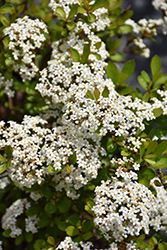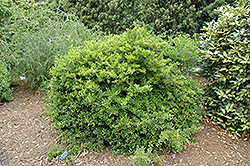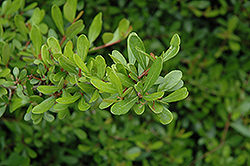It's all about ...
plants

Mrs. Schiller's Delight Viburnum
Viburnum obovatum 'Mrs. Schiller's Delight'
Height: 3 feet
Spread: 4 feet
Sunlight:
![]()
![]()
Hardiness Zone: 8a
Other Names: Dwarf Walter's Viburnum, Black Haw
Description:
A wonderful compact rounded cultivar, with showy clusters of snowy white lacecap clusters of flowers in early spring, followed by red fruit in summer that matures to black; adaptable, makes a great garden specimen
Ornamental Features
Mrs. Schiller's Delight Viburnum is blanketed in stunning cymes of lightly-scented white tubular flowers with buttery yellow throats held atop the branches from late winter to early spring. The red fruits are held in abundance in spectacular clusters in mid summer. It has dark green evergreen foliage which emerges coppery-bronze in spring. The small glossy oval leaves turn an outstanding coppery-bronze in the fall, which persists throughout the winter. The brick red stems can be quite attractive.
Landscape Attributes
Mrs. Schiller's Delight Viburnum is a dense multi-stemmed evergreen shrub with a more or less rounded form. Its average texture blends into the landscape, but can be balanced by one or two finer or coarser trees or shrubs for an effective composition.
This is a relatively low maintenance shrub, and should only be pruned after flowering to avoid removing any of the current season's flowers. It is a good choice for attracting birds and butterflies to your yard, but is not particularly attractive to deer who tend to leave it alone in favor of tastier treats. It has no significant negative characteristics.
Mrs. Schiller's Delight Viburnum is recommended for the following landscape applications;
- Accent
- Mass Planting
- Hedges/Screening
Planting & Growing
Mrs. Schiller's Delight Viburnum will grow to be about 3 feet tall at maturity, with a spread of 4 feet. It tends to fill out right to the ground and therefore doesn't necessarily require facer plants in front. It grows at a medium rate, and under ideal conditions can be expected to live for 40 years or more.
This shrub does best in full sun to partial shade. It is very adaptable to both dry and moist locations, and should do just fine under typical garden conditions. It is not particular as to soil type or pH. It is highly tolerant of urban pollution and will even thrive in inner city environments. This is a selection of a native North American species.
This plant is not reliably hardy in our region, and certain restrictions may apply; contact the store for more information.


